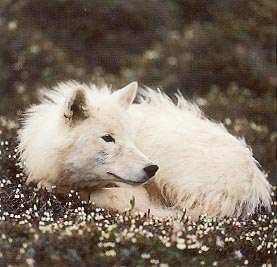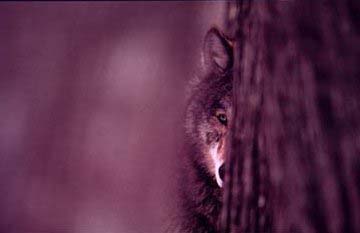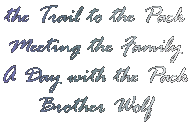|
|
-
The prospect of waking up to the sniffing of a wolf is not something the average person might look forward to. Indeed, the first question that I am invariably asked about my experiences with the pack is, weren't you scared?

- My mother was unflappable as I left to photograph rhinos in Nepal. She greeted my tale of detainment by Russian K.G.B. agents with something akin to amusement. She had never, in short, expressed the slightest fear at any assignment I had ever worked on anywhere in the world, but she greeted the wolf project with maternal anxieties. Every time I prepared to leave for Ellesmere, she would say something like: "You be careful now, living with that pack of wolves. Wolves are dangerous.
- Many of my closest friends had a similar reaction; they thought I'd become slightly daft, and could barely keep from suggesting a panoply of therapeutic options. If only they knew how joyful and relaxed the experience was for me. It was like a vacation, the ultimate wildlife experience, infinitely less stressful than driving in rush-hour traffic.
- The reality of living with wolves is nothing like the Jack London fantasy. But a high percentage of North Americans, it seems, are convinced wolves will attack people, and believe that wolves consider the human jugular a delicacy. This notion of lupine savagery toward humans has its roots in Europe, where anecdotal evidence suggests that wolves may once have been more aggressive toward people. Whether attacks by non-rabid wolves did occur in Europe is controversial; current evidence suggests that if they did, they were certainly infrequent.
- Nevertheless, in North America, confirmed accounts of wolf attacks on humans are virtually unrecorded. Among the only documented examples on our continent involved a construction worker and a Native American woman. In the first case, workers on a particular stretch of the Alaska pipeline "befriended" a pack of wolves and would occasionally toss them scraps of sandwich meat from their lunch pails. One time, an impatient and hungry wolf darted in to snare his offering and bit one of the men in the process. The workers later reported that this wolf had been acting erratically before the attack, indicating the animal was probably sick.
- The other recorded incident occurred in Canada, where the remains of an Indian woman were found in the forest. The woman had a history of epileptic seizures, and there was conjecture that the wolf pack may have found her body after she had died, or that somehow they were triggered into an attack by her behavior during a seizure. It has long been known that wolves will zero in on young, sick, injured, or old prey whose capacities for self-defense are reduced. There are theories that wolves can pick up on sickly energy, that their senses are fine-tuned to detect abnormalities. It is uncanny how quickly they will focus in on the one injured animal in a herd.
- In any event, these two examples represent a few of the rare bona fide attacks recorded after countless wolf-human interactions.
- Our chances of being attacked by a fellow human are vastly greater than any risk posed by a wolf. Every major predator in North America, from mountain lions to grizzly bears, will occasionally strike out against humans, but wolves just don't. While I have asked a number of biologists about this, I have never received a logical explanation.
- Perhaps the answer lies in the peculiar similarities between our species. We are both, after all, social predators who have evolved over the eons in smallish bands designed to kill efficiently. Such a kinship of profession is inescapable. It is, no doubt, also the reason why transmogrified wolves our domesticated dogs are alone among mammals in their ability to stimulate feelings of camaraderie and reciprocal friendship. Truly, from the first time a hunter-gatherer pack of men "adopted" a litter of wolf pups and benefited from the experience, our two species have been bonded in a love-hate relationship.
- Sadly, the hate has all too frequently overshadowed the love. The forces of wolf-hating have been stoked for centuries in our species' collective subconsciousness by tales like "Little Red Riding Hood," with its transvestite grandmother wolf, and "The Three Little Pigs," who are besieged by a wolf that is equal parts big and bad. For generations, parents have used wolves as a demonic metaphor to keep their kids in line.
- In Norway, the language itself keeps this hatred alive. One word for wolf, varg, also means "wild one," "that which cannot be controlled," and "outlaw man." Another Norwegian term for wolf, skrubb, means "unpleasant and threatening creature." Little wonder that anti-wolf clubs and societies thrive in Norway, their members dedicated to tracking down and exterminating the few wolves that still exist there.
- The psychological force of such defamation should not be underestimated, nor should the contemporary, parochial wolf criticisms of humans, from cattlemen to deer hunters, whose economic and recreational self-interests appear to clash with the interests of thriving wolves. Fear of wolves is not limited, of course, to those who have lived around wolves for generations and inherited their biases from their ancestors. One of my northern Minnesota neighbors, a highly educated transplant from the Twin Cities and an environmental sympathizer, regularly jogs the backwoods trails with a .44 Magnum revolver strapped to his side. He wants to have something to protect himself, he says, in case he runs, into a hungry wolf.
- Such rampant nonsense has long made the wolf's prospects less than rosy. Wolves are one of the most persecuted animals on earth. In the Soviet Union and much of northern Europe, a comprehensive program of trapping, bounty hunting, aerial shooting and poison baiting is dedicated to wiping the wolf off the face of that continent. In the continental United States, wolves today occupy less than one percent of their former range. Ten years ago, a Minnesota zealot threw the corpse of a wolf on the doorstep of the Forest Service. He shot the wolf and spraypainted it with a hate slogan despite the threat of a $10,000 fine for killing an endangered species.
- Fortunately, I've seen signs in recent years that the wolf's image is finally starting to turn around. The word is getting out that the wolf is not only an intriguing, but an ecologically crucial part of its habitat. Farley Mowat's entertaining (though partly fictional) account, Never Cry Wolf, has done much to sensitize the public to the wolf's plight. Publishers of wildlife art prints have found that pictures of wolves have emerged as top sellers in the past few years. Similarly, outfitters and guides in wolf country have begun to see increasing interest on the part of tourists hoping to have a wolf experience. An international wolf center has been proposed for northern Minnesota to attract tourist dollars. It has been my experience that people often "get religion" once money enters the picture. That wolf-haters might be converted to wolf-lovers by an appeal to the local economy is surely fine by me.
- For eons, wolves have lived in sophisticated societies of mothers and fathers, aunts and uncles, pups and cousins, and in these groups they have struggled to eke out a living on earth. Time and again, I found myself overcome with respect for the Ellesmere wolf pack and its ways: how every adult pitched in to raise the pups, how they functioned as a hunting unit, and, perhaps most of all, how they seemed to constantly reassure one another with tail wagging, nose touching and howling. The wolf howl remains for me one of the great symbols of the natural world. Even if you never see a wolf but can hear one howling in the wilderness, your life will be enriched by a primal connection with our shared history.
- photos and text by Jim Brandenburg

